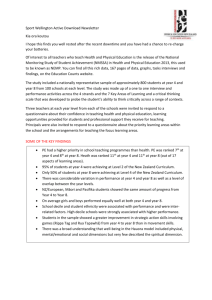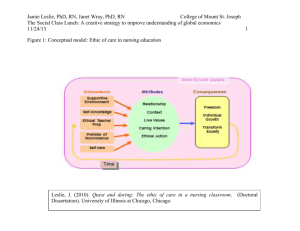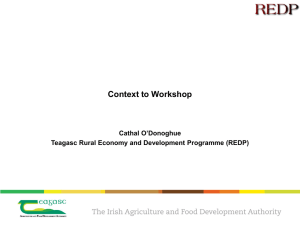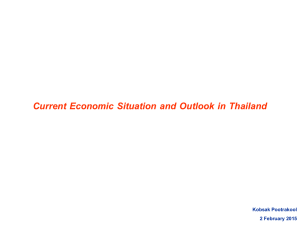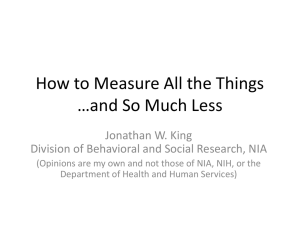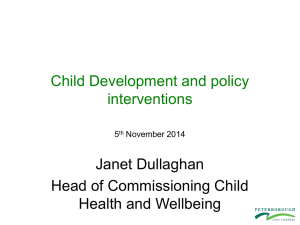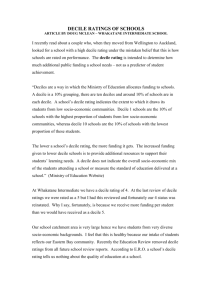A Consistent Food Demand Framework for International Food Security Assessment
advertisement
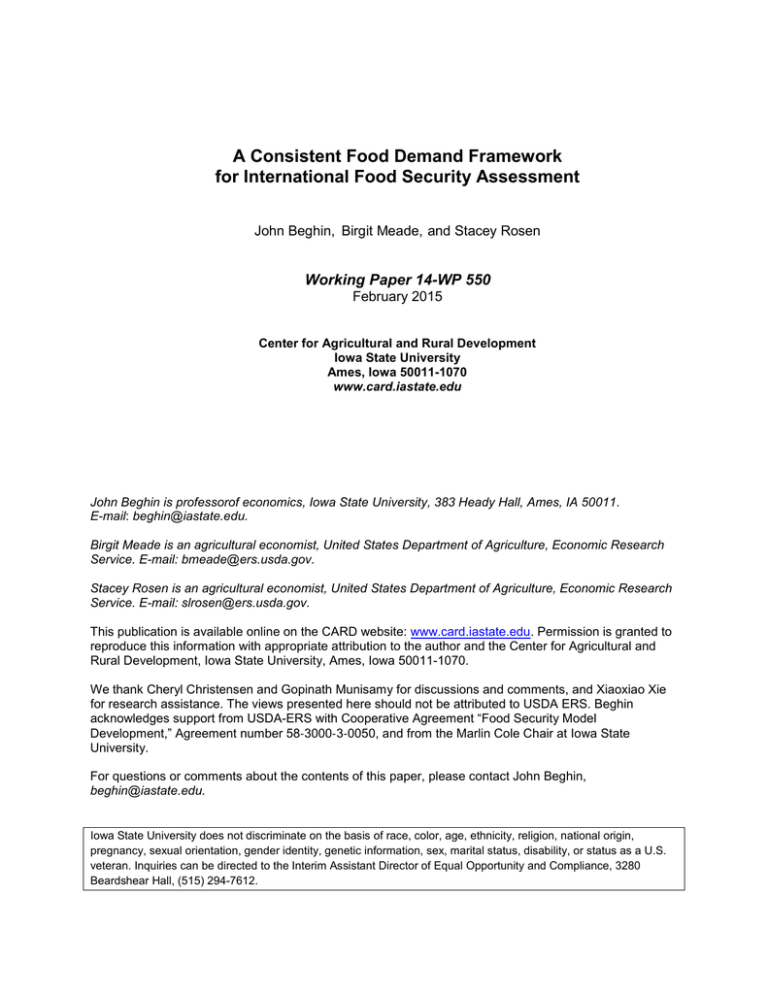
A Consistent Food Demand Framework for International Food Security Assessment John Beghin, Birgit Meade, and Stacey Rosen Working Paper 14-WP 550 February 2015 Center for Agricultural and Rural Development Iowa State University Ames, Iowa 50011-1070 www.card.iastate.edu John Beghin is professorof economics, Iowa State University, 383 Heady Hall, Ames, IA 50011. E-mail: beghin@iastate.edu. Birgit Meade is an agricultural economist, United States Department of Agriculture, Economic Research Service. E-mail: bmeade@ers.usda.gov. Stacey Rosen is an agricultural economist, United States Department of Agriculture, Economic Research Service. E-mail: slrosen@ers.usda.gov. This publication is available online on the CARD website: www.card.iastate.edu. Permission is granted to reproduce this information with appropriate attribution to the author and the Center for Agricultural and Rural Development, Iowa State University, Ames, Iowa 50011-1070. We thank Cheryl Christensen and Gopinath Munisamy for discussions and comments, and Xiaoxiao Xie for research assistance. The views presented here should not be attributed to USDA ERS. Beghin acknowledges support from USDA-ERS with Cooperative Agreement “Food Security Model Development,” Agreement number 58‐3000‐3‐0050, and from the Marlin Cole Chair at Iowa State University. For questions or comments about the contents of this paper, please contact John Beghin, beghin@iastate.edu. Iowa State University does not discriminate on the basis of race, color, age, ethnicity, religion, national origin, pregnancy, sexual orientation, gender identity, genetic information, sex, marital status, disability, or status as a U.S. veteran. Inquiries can be directed to the Interim Assistant Director of Equal Opportunity and Compliance, 3280 Beardshear Hall, (515) 294-7612. A Consistent Food Demand Framework for International Food Security Assessment John Beghin (Iowa State University), Birgit Meade (USDA ERS) Stacey Rosen (USDA ERS)* This version: February 4, 2015 Abstract: We present a parsimonious demand modeling approach developed for the annual USDA-ERS International Food Security Assessment. The assessment focuses on chronic food insecurity. The approach incorporates price effects, food quality variation across income deciles, and consistent aggregation over income deciles and food qualities. The approach is based on a simple demand approach for four food categories. It relies on the existing sparse data available for the Assessment, complemented by own-price and income elasticities and available price data. Beyond consistent aggregation, the framework exhibits desirable characteristics: food quality is increasing with income; price and income responses become less sensitive with increasing income; and increasing income inequality decreases average per capita food consumption. The proposed approach is illustrated for Tanzania. We then use the calibrated model to decompose the impact of income, prices, and exchange rates on food consumption. Next, we assess future food insecurity in Tanzania using the calibrated model and two alternative characterizations of the income distribution (decile based and continuous). Food-insecure population is estimated as well as the implied distributional gap in calorie per day per food insecure person and in total annual food volume in grain equivalent. The latter gauges the depth of the chronic food insecurity. Keywords: international food security, PIGLOG demand, aggregation, income inequality, food prices, shocks, food gap, Tanzania JEL codes: F17, Q17, D31 Contact author: Beghin, CARD and Economics, Iowa State University. beghin@iastate.edu. (515) 294 5811 *We thank Cheryl Christensen, Andrew Muhammad, Gopinath Munisamy, and participants at the 2014 IATRC annual meetings in San Diego, for discussions and comments, and Xiaoxiao Xie and Yiran Xu for research assistance. The views presented here should not be attributed to USDA ERS. Beghin acknowledges support from USDA-ERS with Cooperative Agreement “Food Security Model Development,” Agreement number 58‐3000‐3‐ 0050, and from the Marlin Cole Chair at Iowa State University. This paper has 2 associated Excel files available from the contact author. A small appendix is also attached at the end of this paper. 1. Introduction Food security assessments are challenging (Barrett, 2002). This paper makes a methodology contribution to the literature on country-wide food security assessments (USDA-ERS, 2012, and 2013; and FAO-IFAD, 2014). These types of assessments are typically made under limited and partial information and data because they cover a large set of countries. More specifically, the paper proposes a systematic approach to introduce prices, food quality heterogeneity, and consistent aggregation over income-decile consumption into the economic model currently used by USDA’s Economic Research Service in its annual International Food Security Assessment (USDA-ERS, 2013). The Assessment projects food consumption per decile for 76 low- and middle-income countries for the forthcoming decade and estimates chronic food insecurity and food gaps to reach food security. The proposed approach is designed to be feasible under the scarce information constraining these large food security assessments. This paper derives a food demand system for four categories of foods covered by the Assessment and by income decile. The approach relies on the PIGLOG 1 demand approach in a basic formulation. This paper explains how to consistently aggregate decile food demands into average consumption per capita as a function of average income and a correction factor exhausting all the information on income distribution across population deciles. Many demand systems do not allow for an explicit link between average demand per capita and a distribution of food across deciles. For each food category, the proposed approach explicitly incorporates a measure of the decile income distribution and provides an aggregation of decile demands into a market average demand for that category which is function of average income corrected for income inequality across deciles, as explained below. 1 PIGLOG stands for price independent generalized log-linearity. It is a class of demand systems that provide flexible structure with nonlinear income response and exact aggregation of individual demand into a representative consumer demand function of per capita income and, as shown later, the Theil index of income inequality. -1- Further, the approach allows for variable quality of food items, with quality increasing with increasing income. Various qualities of a given food category are aggregated into an average-quality equivalent that leaves country-level data unchanged, reflecting what happens in the real world. Wealthier consumers upgrade the quality of good they buy relative to poorer consumers. Prices faced by different deciles vary accordingly with quality. Lower-income deciles consume cheaper calories than higher-income deciles do. Within each good category, consumption of heterogeneous qualities can be aggregated over decile in “average-quality” equivalent units. Our characterization of the quality spectrum across deciles uses information from FAO-IFAD’s State of Food Insecurity (SoFI) (see FAO-IFAD, 2014) to estimate the calorie availability of the poorest decile. The integration of these two flagship estimates of food security (USDA’s Assessment and FAO-IFAD’s SoFI) is desirable. It combines the predictive power of the food demand framework and SoFI’s rich information of the distribution of food availability. Domestic and world markets are connected in the proposed approach but with significant transaction costs and trade impediments. Domestic and world prices are linked through synthetic transmission equations including tariffs, real exchange rates, transportation and other trade costs. This paper further explains how to calibrate the demands using the limited information typically available for the annual Assessment. Namely, we use average per capita consumption, data on income and income projections, recent income distribution data, to which we add incomplete data on domestic prices, data on and projections of international prices by USDA to 2023, and sparse estimates of income and own-price elasticities available from USDA-ERS (Muhammad et al., 2011). Cross-price effects are ignored because of the scarcity of cross-price estimates. This paper focuses on Tanzania and the country’s staple grain, corn. Detailed Excel files are available from the contact author. They present the detailed data and calibration of the -2- price transmission equations and the demand system and for the four food categories (corn, other grain aggregate, roots and tubers (R&T), and aggregate all other foods) and with projections for 2013–2023. The model presented here also makes use of information on estimated food consumption from the Tanzania USDA model used in the 2013 Assessment (see USDA-ERS, 2013). Once the calibration completed, we derive estimates of food insecurity first using USDA’s decile-based approach to income distribution and then using SoFI’s information on the distribution of food availability. The juxtaposition of these two approaches allows for validating the respective estimates of population at risk falling below some nutritional targets. In addition, we look at two food availability targets to provide a richer range of estimates (targets x income distribution approaches). We also derive estimates of food gaps, per person and national, to gauge the depth of food insecurity. The remainder of the paper presents the consumer demand specification, followed by the aggregation to market demand, calibration, price transmission equations, quality scaling, and demand decomposition. Then the food security projections are presented with the estimates of population at risk and the associated food security gaps. 2. Specification of consumer demand The motivation for using the PIGLOG specification (Muellbauer 1975; Lewbel 1989) is that it is a general specification well-grounded in micro-economic foundations that allows for nonlinear income response. It allows for an explicit aggregation of demand by the 10 deciles for each good category to an aggregate market demand function of the average per capita income corrected for income inequality, namely the Theil index of income inequality (Theil 1967) summarizing the -3- income distribution over deciles (Muellbauer 1975). Finally with proper calibration, the PIGLOG specification easily exhibits shares of food expenditure that are decreasing with real income. This feature is a stylized fact of food consumption levels determined by income levels. The expenditure shares per good category can be summed-up and demands per category can be aggregated into calories or grain calorie equivalent over categories. In a first step for presentation purposes, we assume quality constant, and then later in the paper, the variable quality and prices using a scaling approach are introduced. The specification of the PIGLOG expenditure share on good category i, wi, is (1) with variable x being the nominal income of the consumer, and with nominal price pi and price index P for all other goods, which can be approximated by a CPI. Functions A and B are homogenous degree zero in nominal prices pi and P. We normalize P to 1 without any loss of generality and rewrite the share as with price and income variables being in real terms from now on. Marshallian demand qi is (2) We further specify Ai(pi)=aio + ai1 pi, and Bi(pi)=bio+bi1 pi. Other specifications are possible. This one is parsimonious and focuses on the own-price response. All other cross-price effects are subsumed in parameters aio and bio. When data and cross-price estimates are available, more elaborate responses can include cross-price effects in future refinements and elaborations. The income elasticity of demand i is , (3) -4- which is decreasing in income if Bi is negative. Equation (3) accommodates normal or inferior goods and a range of elasticities over deciles as the share of expenditure wi varies by decile. The own-price elasticity is ε q p =−1 + ( pi / wi )((bi1 ln( x) + ai1 ). i (4) i Equation (4) also accommodates a range of elasticities by decile as income and share of expenditure vary by income decile. When calibrated appropriately, income elasticity (3) is decreasing with income. Similarly, the absolute value of price elasticity (4) can be calibrated to be decreasing with income. A free parameter in the calibration allows imposing such patterns as explained below in the calibration section (see Section 4). 3. Aggregating decile demands to the average aggregate demand for good i The PIGLOG formulation allows for aggregation of decile-level demands for any good into the total market demand which can be expressed as an average per capita market demand which is as function of average income corrected by the Theil’s entropy measure of income inequality among income classes (Muellbauer 1975) and which uses the same preference parameters as the demand of any individual decile. Here, we assume a distribution of income by population decile, which is the way USDA and many other agencies assess at-risk groups with respect to food insecurity (i.e., the lowest-income deciles being assessed). Using superscript h to denote decile-specific variables with h=1,…,10, we have decilelevel food demand as (5) Equation (5) leads to average per capita demand is a function of average per capita income by simple aggregation over deciles. The latter and Theil’s entropy measure of income inequality z -5- measured on the decile income distribution: (6) with (7) Entropy measure z reaches its maximum at 10 when all deciles have similar income. In this case ln(10/z) equals zero. Any income inequality leads to (10/z) > 1. Given some inequality and a negative value for Bi(pi), it can be seen that income inequality decreases the level of average consumption per capita for the corresponding good category. As shown in (6), abstracting from income inequality will overstate average demand relative to the average demand implied by the individual decile demands. With our chosen specifications of Ai(p) and Bi(p) as defined previously, we can further express average demand for good i as (8) We also define average expenditure share for good category i as . (9) The elasticity of average demand for good i with respect to average income (or total expenditure) is ε qi x = 1 + ( Bi ( pi ) / wi ) = 1 + [(bio + bi1 pi ) / wi ]. (10) The own-price elasticity of the average demand is ε q p =−1 + ( pi / wi )(bi1 (ln( x ) + ln(10 / z )) + ai1 ). (11) i i All consumers in different deciles have similar underlying preferences over good i as embodied in parameters aio, ai1, bio, bi1, and their respective consumptions vary because their respective -6- incomes vary. 4. Calibration for good i Data on average consumption, average income, price, and decile income distribution are available from the Food Security database maintained by USDA-ERS and which relies substantially on FAO data for the food availability. From the decile income distribution data, one can compute the Theil index (equation (7)). Using equations (9) through (11) for the average expenditure share and the two elasticities of average demand for good i, demand calibrated. Then, individual decile demands can be can be calibrated using the parameters recovered in the calibration of the average demand. The calibration uses the observed average expenditure shares of good i, an estimate of the two elasticities for the average demand, and a specified value of a free parameter as explained below. With a system of three linear equations (equations (9)–(11)) with four unknown variables, one parameter remains free. The free parameter (chosen to be bio) is used to insure that decile demands behave consistently with stylized facts of food security as follows. Price sensitivity and income responsiveness decline with income levels; own-price elasticities must be negative; and food expenditure shares tend to fall with increasing income. A range of values of the free parameters allows insuring these stylized facts are satisfied by the calibrated demand system. Here we illustrate by pinning down bo such that the ratio of price elasticities for the bottom and top deciles is equal to the ratio of the natural logarithm of their income shares of GDP in the base year (see point 1 below). For any given free parameter value, the system of equations is solved for parameters bi1, ai1, and aio as a function of the free parameter. Once these three parameters are recovered, the -7- decile demands and their corresponding elasticities are computed based on the decile income levels and the aggregate elasticities. This step relies on the four parameters (one free parameter and three calibrated) and equation (2) with Ai(pi)=aio + ai1 pi, and Bi(pi)=bio+bi1 pi for the demands and (3) and (4) for each decile elasticities. The calibration is recursive. Four steps are involved: 1. We pin down bo such that the ratio of calibrated price elasticities for the bottom and top deciles equal to the ratio of the natural logarithm of their national income shares in the base year. Else, there is range of values of bo that satisfy the calibration. This ratio is 2.932 for Tanzania. 2. Parameter bi1 is then recovered from the income elasticity estimate of and for a given value , both denoted by hats, that is, Tildes denote calibrated values. 3. Next, the calibrated value of the ai1 parameter is recovered, given calibrated parameter estimate of the own-price elasticity of the aggregate average demand for good i , an , and the observed average income and Theil index z. The expression for the calibrated value of parameter ai1 is 4. The calibrated value of the last parameter aio is recovered from the average share of expenditure (9), -8- . and price pi are used to generate the Parameters consumption level of good i for each decile. Similarly, one can compute the associated decilespecific elasticities of demand with respect to income and price using equations (2)–(4). Again, in this initial calibration, the quality of any good i is assumed constant across deciles. Step 4 completes the calibration and characterization of each decile’s consumption of any given good i, and assuming that quality remains the same across all deciles. The four-step process illustrates the link between decile demand and aggregate market demand. It also demonstrates the correspondence between income and price responsiveness of the average and individual per-capita demands through aggregation over individual decile demands. In the context of the food security outlook, the same sequence of steps is undertaken for four categories of food in Tanzania (corn as the staple grain, other grains, R&T, and all-other-foods aggregate). An example of such calibration is provided in the Excel files previously mentioned along with the calibration for the four good types and the decile consumption in the base year of 2012. The four categories will be common to all potential countries included in the assessment; but the staple grain is country-specific, and the composition of “other grains,” R&T, and “all other foods” will also be country specific but all expressed in gran equivalent. Price index for aggregate category Three of the goods (other grains, R&T, and aggregate all other foods) include several commodities. For goods with international and/or domestic price data available (i.e., grains), we use a weighted (by share of consumption) price index aggregating prices of various grains into a grain composite price index. For other products (R&T and all other foods), this approach does not appear sound, as nutritional content per unit of weight varies dramatically over goods (i.e., -9- dairy, meat, oils, vegetables). Their aggregation is done on a grain-based equivalence. For R&T, the international price of cassava is used as a representative world price and is linked to local prices of R&T such as yam or manioc from FAO GIEWS whenever available for 2012. All prices are in grain equivalent. The price of vegetable oil in grain equivalent is used as a representative price for “all other food.” This is not ideal, but oil tends to be an important component of other foods in most countries and its international price is readily available. Other “representative” commodities could be used. Synthetic price transmission equations are used to link the world and domestic prices expressed in grain equivalent. These are explained in detail in the next section. The transmission equation includes tariffs and transportation costs from world markets to the domestic market as well as the effect of the real exchange rate. They also assume a less than perfect transmission between world and domestic prices. Aggregation over the four types of goods Next, the aggregation of the four food types is considered to derive a calorie or grain equivalent to the estimated demands. The aggregation is feasible because the four food categories are expressed in calorie-equivalent as done in FAO’s food balance sheets and can be easily expressed in grain-equivalent (or any food item equivalence) from calorie-equivalent. Each food category is characterized by a grain or calorie energy intake per unit of consumption. Naturally, the 4 demands can be aggregated to a total grain or calorie equivalent, which in turn responds to price and income via the economics underlying each of the four food demand components (major grain, other grains, R&T, and all other foods). Table 2 shows the calibration for corn per decile for Tanzania. - 10 - 5. Price transmission equations Following the work of Mundlak and Larson (1992), Campa and Goldberg (2005) and others, the price transmission equation links the local real consumer price of good i to the corresponding world market price and embodies the influence of world prices, international transportation, exchange rates, trade policy, and other transaction costs arising from bringing commodities to local markets. Each real consumer price for any tradable importable commodity i is linked to the corresponding world market price as follows: (12) where θ is the slope indicating the strength of transmission between the world price and the domestic price, ER is the nominal exchange rate in local currency units per U.S. dollar, wpi is the FOB price of commodity i, trc denotes trade and transportation costs in the international market (int subscript) in ad valorem form and in the domestic market of the importing country in specific form (dom subscript); tariff denotes the sum of all specific and ad valorem tariffs imposed on the good and expressed in ad valorem form, and where P is the CPI deflator (or GDP deflator) in the importing country as defined previously. Trade and transportation costs can be commodity specific. In a world of perfect transmission, 𝜃𝜃 is equal to 1. Note that (12) can equivalently by expressed with world price wp expressed as a real world price rwp (real constant US dollars/mt), real exchange rate RER (real local currency units (LCU) per real US dollar), and real trade costs rtrc other than tariffs and international transportation cost in real LCUs, and then not further deflating by the local CPI deflator P. This step yields: . (12’) Other specifications than (12) or (12’) are possible, especially if econometric estimates of price - 11 - transmissions are available. An intercept can be added, or a slope coefficient to (12) to reflect the econometric estimates of a regression of the type (p = a + b wp). The additive form of (12) and (12’) provides a price-transmission elasticity (dlnp/dlnrwp), which is less than one by construction as long as some additive tariff or trade costs are present and can be further lowered by setting the slope parameter θ to a value smaller than 1.For example in the Tanzania illustration we assume a slope θ of 0.7. For the implementation of the price transmission equation, there are two cases: (a) both domestic and international prices are available, and an intercept (which subsumes all trade costs between world and domestic markets) can be derived to link the two prices expressed in similar real LCUs; or (b) only the international price is available and a synthetic domestic price is estimated using the price transmission described in (12). To compute (12), tariffs are obtained from the WTO website (WITS and/or Macmap databases are also alternatives); the CPI deflator P is available from the USDA-ERS macro database; FOB/CIF ratios are estimated at 1.10 in ad valorem form for importable goods and not accounted for in the case of exportable. Similarly tariffs are not included for exportables since the price signal at the margin is in the export market. Domestic trade costs are assumed to be $20 per metric ton of grain equivalent (2005 real prices). World price data are obtained from USDA’s world outlook which allows making 10-year projections. These transmission equations are shown in table 1 with the implied intercept between world and domestic price expressed in similar real LCUs. See the Excel files for further details. 6. Quality scaling Consistent with real-world observation, it is assumed that the quality of good i increases with - 12 - income and that its price is also increasing with quality. Therefore, low-income consumers consume cheaper quality purchased at a lower price and vise-versa for higher income consumers. We posit that quality is represented by a scaling factor µ(x) which, when normalized appropriately over all deciles, is equal to 1. The scaling factor scales quality and prices down such that the product of quality-adjusted quantity consumed and prices remain constant (quantity adjusted for quality and price move in opposite directions such that the estimated expenditure share is invariant to quality. The quality-scaling approach can be rationalized using the framework of Cox and Wohlgenant (1986) of hedonic prices in which households in different income deciles chose quality as part of their utility maximization problem. We do not attempt to model this hedonic choice explicitly here, however. Using equation (2) and a definition of the scaling factor µ we have a quantity consumed with variable quality for any good i and decile h h / µih ( x h / µih pi ) ( Ai ( pi ) + Bi ( pi ) ln( x h ) ) , = q ihadj q= i (13) with µih > 0 ∀h, and 10 ∑ (q h =1 h i / µih ) /10 = qi . (14) h ≥ q ih with µh Low-income deciles consume goods of cheaper quality in greater abundance ( q iadj smaller than unity) and richer consumers do the opposite by consuming higher quality goods in h ≤ q ih with µh larger than unity). smaller amount once expressed in quality-adjusted units ( q iadj The scaling is calibrated such that on average over deciles, the mean of the variablequality consumption levels is equal to the mean consumption per capita holding quality constant as expressed by equation (14). Expenditures are invariant to scaling since the price and quantity are inversely scaled and offset each other. One can think of consumption in average-quality - 13 - equivalent (in equation (2) or in variable-quality units in equation (13)). To compute calorie availability, equation (13) is used. To calibrate the demand system, equation (2) is used and then we impose the scaling on top of the original demand calibration. To do so, a reference consumption level is established in variable-quality units for the first (lowest) decile, which is 1 represented by qiadj min in equation (15) below. The scaling parameter µ for good i and decile h is derived using the adjusted consumption level as follows: q h = (α + β q ih ), or iadj = µih q ih / (α + β qih ), (15) with 1 1 1 1 (qi − qiadj qiadj β= min ) / ( qi − q i ) and α = min − β q i . For the Tanzanian model illustration we use the 1st decile per capita availability implied by FAO-IFAD’s State of Food Insecurity (SoFI) in 2014 and updated data on food availability as explained in the paper appendix. This availability for the 1st decile is 138.1 kg of grain equivalent (rounded) per year in Tanzania, or equivalently 1239 calories per day. Each of the four goods contributes proportionally to the first decile’s reference consumption level and each is scaled up to sum up to the aggregate reference consumption level. The constraint of having the mean quality equal to 1 over all deciles provides a second equation to establish how quality evolves over deciles in any given year. The demand-weighted-average scaling factor is equal to 1, such that the scaling does not “create” consumption in the aggregation over decile. The sum of all consumption over deciles with variable quality sums up to the same food volume estimated assuming constant average quality. Over time, this minimum consumption in adjusted units is allowed to grow slowly - 14 - following the projected distribution of food availability in the country as explained in the appendix. To illustrate with Tanzania, quality increases are included by first scaling up each consumption for the four categories to achieve a minimum aggregate calorie intake of 1,239 calories per day for the lowest decile in the base year. We derive a proportional minimum consumption and scaling schedule for each of the 4 food types (corn, other grains, R&T, all other foods) so that aggregation holds through to reach 138.1kg/year. The quality scaling for corn is shown per decile in Table 2 (see column labelled “quality scale”) for the base year. The quality scaling structure in the base year is illustrated in the Figure 1 for the four goods included in the Tanzanian model. The figure shows how the scaling evolves as income changes, moving across deciles in any given year. Quality scaling by food type over decile income base year 1.10 1.05 scale 1.00 corn 0.95 other grains R&T 0.90 other food average quality adjustment 0.85 decile income range in PPP 2005 lcu 0.80 0 200,000 400,000 600,000 800,000 Figure 1 - 15 - 1,000,000 1,200,000 1,400,000 Over time as income increases, the lowest decile’s consumption grows with income. We let quality increase as well (the scaling factor slowly increases, but remains below 1 for the lowest income groups), which translates into a net increase in the lowest-decile consumption when quality is accounted for. Conversely, for deciles starting with above-average quality (scaling factors larger than 1 in the base year), as income progresses, quality adjustments relative to the mean quality eventually decrease and even cease if the non-adjusted availability of the good for the 1st decile is at least as large as the minimum implied by the variable-quality approach. The range of quality differences across deciles shrinks over time as average income increases. This feature is a consequence of imposing the demand-weighted average quality equal to 1 in all years. There is some intuition to this feature—quality dispersion decreases when everyone’s income rises. As the population average of food availability increases in the projected period, the availability of calories also increases for the bottom decile. We then use this projected bottom decile availability to calibrate quality as explained in previous paragraphs and we do so for every year from 2012 to 2023. Figure 2 illustrates this change over time in scaling for the 1st decile in the Tanzanian model and for the quality adjustment averaged over the 4 food types. - 16 - quality adjustment 1st decile with average income rising over time 0.960 0.940 0.920 0.880 scale 0.900 0.860 average quality adjustment over time 0.840 0.820 0.800 average income per capita 2012-2023 Figure 2. 7. Decomposition of projected demand by its determinants In this section, a decomposition of the projected growth of demand is illustrated from 2012 to 2023 induced by changes in its determinants. Total demand growth is decomposed into per capita demand growth and population growth. Then, per capita demand growth is further decomposed in terms of the income response and the price response, which itself is decomposed into a real world price response and real exchange rate response. The growth of projected total demand is then approximated by linearization as in Dong, (2006), Heien and Wessells (1988), and Shui et al. (1993). The decomposition for infinitesimal changes is with totQi denoting total food demand for commodity i, pop denoting population of the country, - 17 - and with ε pi rwpi being the price transmission elasticity. The growth rates (Δx/x)) are taken from 2012 to 2023. Note that second equation in (17) is an approximation since the elasticities are endogenous and vary with price, quantities, and income. The price transmission elasticity for corn in Tanzania is 0.549 evaluated in 2012 prices. We compute the effects as follows. For the ,𝑥𝑥̅ 2012 ) 2012 ,𝑥𝑥̅ 2012 ) 𝑞𝑞�(𝑝𝑝 domestic price effect on per capita demand, we look at � �(𝑝𝑝2023 𝑞𝑞 − 1� with real domestic price p(rwp, RER) defined as in equation (12’). This effect is then allocated proportionally to the relative changes in the RER and rwp between 2012 and 2023. For the income effect on per capita 𝑞𝑞�(𝑝𝑝 demand, we look at� �(𝑝𝑝2012 𝑞𝑞 ,𝑥𝑥̅ 2023 ) 2012 ,𝑥𝑥̅ 2012 ) − 1�.The sum of the two effects (domestic price and income) are then summed up to approximate the relative change in per capita demand induced by the price, exchange rate, and income changes. The decomposition is shown in Table 3. Based on the calibrated demands, total food demand for corn in Tanzania national demand for corn/maize is projected to increase by nearly 76% in the projected decade given the trajectory of projected real income per capita (+18%), real world price for corn (-49%) real exchange rate (-22%), and population (+35%). Per capita demand is projected to grow by 30% based on the calibrated demand per capita (equation (8)). The interaction of population growth and that of per capita demand is responsible for 11% growth of total demand (76% = 35% + 30% + 11%). Again, the latter figures are obtained using the calibrated demand. The decomposition of the demand growth per capita shows that the change in the real world price after being scaled by the own-price elasticity and the price transmission elasticity is the most important contributor to per capita demand growth (14% growth of per capita demand). The real appreciation of the Tanzanian currency, after proper scaling by elasticities, leads to 6% of per capita demand growth. Finally, income growth contributes 9% growth of per capita - 18 - demand. The approximation of per capita demand growth is not perfect, of course, and misses a bit less than 1% of projected growth of per capita demand. The unaccounted change come from interaction between price and income changes and from the linear approximation implied in equation (16). The latter shortfall is slightly accentuated in the total demand projection, which is about 2.56% of growth short of the projected change (75.88% versus 73.39%). Similar decompositions could be computed by decile for which an additional factor could be added, that is, the quality scaling and its evolution over time. Since the quality scaling is normalized to 1 for aggregate demand in every year, the growth of total food demand is invariant to quality scaling. 8. Food security assessment 8.1. Indicators Two food insecurity indicators are estimated for the current year as well as ten years out: the number of food insecure people and the distribution gap, explained below. The main focus and contribution of the Assessment model is its projection of food demand by income group, as described in detail in the preceding sections of this paper. This focus on individual income groups allows for the analysis of the access dimension of food security, which looks at the question of whether households have sufficient purchasing power to buy the food they need. For this purpose, we use the decile food demands, subject to income constraints and responding to price signals for the 10 income groups. This decile food demand is then compared with a nutritional target to determine whether a given income group would be considered food secure. We use two nutritional targets, based on a daily caloric intake standard of 1800 and 2,100 calories per capita per day. The caloric target is converted into grain equivalent quantities using conversions which are similar to those used in the construction of the food availability data. - 19 - USDA has used the 2,100-daily calorie target (234 kg of grain equivalent per year for Tanzania). The 1,800-calorie target represents an alternative for sedentary people. There is no universal standard for food security but these two targets are plausible and provide a range. We use two approaches to the distribution of income, one based on the decile distribution of income, the other based on a recovered lognormal distribution of food intake from SoFI. Using the decile approach, if the estimated decile food demand falls below the target level, the entire income group (decile) is counted as food insecure. Aggregating the people in these fooddeficit income groups provides one of our food insecurity indicators—the number of chronically food-insecure people. Still under this decile approach and to provide an indication of the depth of food insecurity, we look at food gaps between the estimated food consumption level of food insecure groups and the target level. This gap can be expressed on a per capita basis in daily calories. The objective is to allow each income decile to reach the nutritional target. If food demand based on incomes and prices in a given income decile is lower than this target, that difference is part of the gap for this country. The gaps for all income deciles are added up to determine the gap for a given country in volume of grain equivalent in 1000 metric tons. The latter gap measure can be expressed as the total amount of food required to allow each income decile to reach the nutritional target (1800 or 2100 calories/day). For the second approach to the distribution of income, we rely on SoFI data to estimate the distribution of calorie availability which is a monotonic transformation of the income distribution. SoFI provides information on the distribution of food intake for 170 countries. It indicates the shape of the distribution (lognormal, normal) and provides the mean caloric intake and the coefficient of coefficient of variation of the calorie availability. The coefficient of variation is based on income variation estimated from surveys. We use this information, slighted - 20 - updated, to characterize consumption as distributed with a mean m and variance v. We explain this in details the attached appendix. The coefficient of variation (CV) of food availability for √𝑣𝑣 each country is CV=� �, where v is the variance of the empirical distribution which can 𝑚𝑚 recovered given the mean and the CV as indicated in the appendix for the base year. Assuming food availability qcal is distributed lognormal, then ln(qcal) is distributed N(µ,σ2) with µ= ln(m 2 v + m 2 ) and σ 2 = ln(1 + (v m 2 )) . Once µ, and σ2 are computed, we can recover the proportion of the population that falls below the calorie target (1800 in the next equation) using the equation (ln(1800) − µ )/ σ Φ in sec ure = Φ ((ln(1800 − µ) / σ ) = ∫ −∞ 1/ 2π e(ln(1800) −µ ) 2 /2 σ 2 ) d qcal . (18) A similar equation holds for 2100 calories. Function Φ indicates the CDF of the standard normal distribution, and Φinsecure indicates the proportion of the population that is food insecure. in sec ure Next the average food intake of food insecure people, q calfoodaverage , can be recovered using the partial mean of the calorie availability below the target (1800 here in the equation), which is obtained using ( ) E ln(q calfood in sec ure ) | ln(q cal ) < ln(1800) = µ − σ [φ ((ln(1800) − µ ) / σ ) / Φ ((ln(1800) − µ ) / σ )] , (19) and leading to in sec ure q calfoodaverage = e µ −σ / Φ 1800 [φ ((ln(1800) − µ )/σ )] (19’), where φ is the standard normal density function. The food gap can be computed by looking at the difference between the target and the average calorie availability for food insecure consumers. This provides a gap in calories per day per insecure person. The latter can be - 21 - multiplied by the population at risk and converted in grain equivalent per year to yield a gap indicator based on annual grain volume as under the decile-approach. Note that with this second approach to the distribution of income, the mean caloric availability for the country increases over time. If the CV is maintained constant, then the Theil index for that distribution is assumed constant as in the Assessment. Both mean and standard deviation are growing at the same growth rate to keep the income ratios (decile income/average income) constant in the Theil index. However, here we are dealing with the Theil index of calorie availability which is slightly different than the Theil index of income, given that income elasticities decrease as income increases across deciles. We abstract from this possibility here. 8.2. Assessment The assessment of food security is shown in Tables 4 and 5. Table 4 presents the projected population at risk for the 2 targets (1800 and 22100 calories/day) and the two approaches to income distribution and for projections over the decade (2012, 2013, 2018, and 2023)). Table 5 shows the implied projected food gaps for similar years. In the decile method, if an estimated decile food demand falls below the target, the entire income decile is counted as food insecure. Aggregating the people in these food-deficit income deciles provides the number of food-insecure people. Hence, the variation in food-insecure population changes by 10%-increments when population deciles come in or out of food insecurity. The method is informally illustrated in Figure 3. All deciles falling below the red line of 234 kg (2100 calories/day) are deemed food-insecure. One can also gauge the food gap between the target and consumption level by decile from the figure. The gap provides an indication of the depth of the insecurity. - 22 - Both approaches concur that population in the first decile will remain food insecure even under the low threshold of 1,800 calories. Under the more stringent criterion of 2,100 calories, people in the two bottom deciles will remain food insecure in 2023. In those later years, the decile approach overstates the share of population (20%) that is food insecure compared to the distribution-based estimate of 13%. Table 5 shows that the 180 calorie target is more modest and provides a calorie gap that are smaller than under the more stringent calorie target of 2100 calories. It also shows that the lognormal approach tends to projects less pronounced decreases in the calorie gap per insecure person over time, as compared to the decile-approach. Both approached provide comparable estimates of annual good gaps ingrain equivalent of about 1 million metric tons in the base year with the 2100-calorie target and roughly half of that volume with the 1800-calorie target. The annual grain gaps fall by more than two thirds by 2023 to around 300 thousand tons per year with the high target, and by more than three quarters to roughly 100 thousand ton with the 1800calorie target. The rapid decrease is caused by the projected income growth and increase in average food availability over time. - 23 - 700 Projected total food consumption in grain equivalent by income-based population decile in Tanzania decile 1 600 decile 2 kg of grain equivalent per capita per year decile 3 decile 4 500 decile 5 decile 6 decile 7 400 decile 8 decile 9 decile 10 300 234 kg 214.4 194.9 200 100 2012 224.5 204.1 168.3 176.1 138.1 144.2 2013 223.4 192.2 156.4 2014 2015 215.6 218.7 221.5 224.2 227.4 230.6 233.9 204.5 212.4 165.7 171.6 174.1 176.4 178.6 180.6 183.0 185.4 187.8 2016 2017 2018 2019 2020 2021 2022 2023 Figure 3. Redline at 234 kg indicates the cutoff for food insecurity of 2100 calories/day 9. Summary and concluding remarks This paper presented a parsimonious modeling approach to incorporate price effects, quality variation, and consistent aggregation over income classes and food qualities in a food demand system. The approach can be used to assess calorie intake per decile, to investigate income, price, and exchange rate shocks, and could be applied to improve USDA’s International Food Security Assessment model. The approach is based on a simple PIGLOG demand approach for four food categories (major grains, other grains, R&T, and an aggregate all other food). The approach relies on the existing sparse data available for these assessments, which is a desirable feature. The proposed - 24 - approach was illustrated for Tanzania. The calibration was then used to decompose the impact of changes in population, income, world price, and real exchange rate on food demand over the 2012–2023 projection period. Finally, we projected the population that would be food insecure and the associated food gaps. The methodology provides estimates of chronic food insecurity, but it could also be used to analyze the consequences of shocks in income, world prices and exchange rates on food security such as those that have occurred in the last decade. As proposed in this paper, the combination of USDA’s Assessment with SoFI information on the distribution of food availability provides an outlook of food security anchored in the most up-to-date information of SoFI and which incorporates food demand responses to projected populations income and price changes to project future food insecurity. - 25 - References Barrett, Christopher B. 2002. "Food security and food assistance programs." chapter 40 in B.L Gardner and G.C. Rausser, eds. Handbook of Agricultural Economics 2B: 2103-2190. Campa, Jose Manuel, and Linda S. Goldberg. 2005. "Exchange rate pass-through into import prices." Review of Economics and Statistics 87.4: 679-690. Cox, Thomas L., and Michael K. Wohlgenant. 1986. "Prices and quality effects in crosssectional demand analysis." American Journal of Agricultural Economics 68.4: 908-919. Dong, Fengxia. 2006. “The outlook for Asian dairy markets: the role of demographics, income, and prices.” Food Policy, 31(3), 260-271. Food and Agriculture Organisation (FAO), and International Fund for Agricultural Development (IFAD). 2014. The State of Food Insecurity in the World 2014. Strengthening the Enabling Environment for Food Security and Nutrition. Heien, Dale M., and Cathy Roheim Wessells. 1988. "The demand for dairy products: structure, prediction, and decomposition." American Journal of Agricultural Economics 70.2: 219-228. Lewbel, Arthur. 1989. "Household equivalence scales and welfare comparisons." Journal of Public Economics 39.3: 377-391. Muellbauer, John. 1975. "Aggregation, income distribution and consumer demand." The Review of Economic Studies 42.4: 525-543. Muhammad, Andrew and Seale, James L. and Meade, Birgit and Regmi, Anita. 2011. International Evidence on Food Consumption Patterns: An Update Using 2005 International Comparison Program Data (March 1. USDA-ERS Technical Bulletin No. 1929. Available at SSRN: http://ssrn.com/abstract=2114337 or http://dx.doi.org/10.2139/ssrn.2114337). Mundlak, Yair, and Donald F. Larson. 1992. "On the transmission of world agricultural prices." The World Bank economic review 6.3: 399-422. Shui, Shangnan, John C. Beghin, and Michael Wohlgenant. 1993. "The impact of technical change, scale effects, and forward ordering on US fiber demands." American Journal of Agricultural Economics 75.3: 632-641. Theil, Henri. 1967. Economics and information theory. Vol. 7. Amsterdam: North-Holland. USDA-ERS. 2012. International Food Security Assessment, 2012-22, International Agriculture and Trade Outlook GFA-23 July. USDA-ERS. 2013. International Food Security Assessment, 2013-23, International Agriculture and Trade Outlook GFA-24 June. - 26 - Table 1. Price transmissions in Tanzania and supporting data used for 2012 Price transmission in Tanzania (prices are per metric ton) exportable/importable observed Domestic International International price or price in price in Real location from USDA synthetic Real LCU LCU in Commodity Outlook in grain grain equivalent equivalent Major grain (maize) All other grains Maize/corn Rice Wheat importable importable importable obs obs syn 2864045 938911 287,338 224806 465782 236094 Sorghum Millet Barley importable exportable importable syn syn syn 218,461 166,265 247,308 214927 214927 213216 331955 1198254 357543 grain index price R&T Cassava importable syn 555,363 1,316,778 Other food soy oil importable syn 342,712 RER CPI us CPI Tanzania CIF/FOB Taxes: AHS wheat Taxes: AHS Sorghum Taxes: AHS Millet Taxes: AHS Barley Taxes: AHS Maize Taxes: AHS Rice Taxes: Soy oil Taxes: Cassava Slope of transmission θ 929.70 117.56 197.07 10% 0.31 0.13 0.25 0.25 0.33 0.29 0.1 0.25 0.7 - 27 - USDA USDA Thailand USA hard red winter USDA USA sorghum USDA US sorghum USDA USDA Rouen barley price computed USDA: Internat. cassava USDA: Soy oil Implied intercept (DP-θWP) 129040 612864 122072 68013 15816 98057 322995 478000 92432 Table 2. Demand calibration and quality adjustment per income decile for corn demand in Tanzania Data and calibrated implied parameters used to decile daily income computed computed annual calibrate the average calories decile decile consumpt. shares by computed PIGLOG demand from decile in demands kg income decile price expenditure quality corrected 2012 base year value unit decile %(data) per capita elasticities elasticities share maize scale for quality average income data average corn quantity consumed (data) aggregate income elasticity (data) aggregate price elasticity (data) consumer price major grain (data) Thiel index (ln(10/z)) computed from decile data average expenditure share (data) bo free parameter (set freely) b1 (computed) 444171.9 real lcu/ capita 1 2.82 34.77 0.74 -0.56 0.080 311.98 0.85 40.76 365.77 74.580 kg/capita 2 3.98 44.60 0.71 -0.54 0.072 400.22 0.91 49.11 440.74 0.563 unitless 3 5.11 53.11 0.69 -0.52 0.067 476.54 0.94 56.34 505.59 -0.413 unitless 4 6.00 59.21 0.67 -0.50 0.064 531.28 0.96 61.52 552.10 286.4048 real lcu/kg 5 7.00 65.58 0.65 -0.49 0.060 588.43 0.98 66.93 600.66 0.229018 unitless 6 8.56 74.56 0.63 -0.47 0.056 668.97 1.00 74.56 669.10 0.04809 unitless 7 9.55 79.78 0.61 -0.45 0.054 715.79 1.01 78.99 708.88 8 12.15 91.98 0.57 -0.42 0.049 825.31 1.03 89.36 801.94 9 15.22 104.04 0.52 -0.38 0.044 933.48 1.04 99.61 893.85 10 29.61 138.18 0.30 -0.19 0.030 1239.80 1.07 128.61 1154.13 -0.01648207 -0.00001583 0.00030801 a1 (computed) ao (computed) daily calorie adjusted for quality 0.23796806 - 28 - Table 3. Decomposition of projected corn demand in Tanzania Decomposition of projected total demand in terms of growth of population, income per capita, world price, and real exchange rate between 2012 and 2023 2012-2023 Approximated Explanation projected effect on demand in Variable rate of % change Population (1) 35.27% 35.27% (total population shift, holding per capita demand) demand constant. Real PPP income (2) 17.58% 9.26% (per capita income shift of per capita demand demand) using arc elasticity of income, other things constant Real world price (real -48.73% 13.99% (per capita price response of per capita demand US $) (3) demand) to world price change Real exchange rate (3) -22.29% 6.40% (per capita price response of per capita demand (the cost of a real $) demand to change in real exchange rate Projected per capita 30.02% 29.65% (per capita sum of income, world price, demand (5) as per demand) exchange rate effects on per capita calibration demand. Linearized approximation Projected total 75.88% 75.39% combined estimated per capita and national demand (6) as population effects (sum + product of per calibration and relative changes). Note the projection approximation misses 0.49% of the projected change (75.88% versus 75.39%) - 29 - Table 4. Projected food insecure population in Tanzania. (Estimated with 2 food security targets and 2 methods) Food insecure population Year 1800 calorie target Lognormal approach Percent of population falling below 1800 calorie/day Lognormal approach Food insecure population 1800 calorie target USDA decile approach Percent of population food insecure 1800 calorie/day USDA decile approach Food insecure population 2100 calorie target Lognormal approach Percent of Food population insecure falling population below 2100 2100 calorie calorie/day target USDA Lognormal decile approach approach Percent of population food insecure 2100 calorie/day USDA decile approach 2012 11,571,381 24.67% 14,073,830 30% 18,944,397 40.38% 18,765,107 40% 2013 10,088,020 20.90% 9,652,388 20% 17,198,274 35.64% 19,304,777 40% 2018 4,581,702 8.26% 5,545,134 10% 9,541,100 17.21% 11,090,269 20% 2023 3,718,825 5.86% 6,346,112 10% 8,267,888 13.03% 12,692,225 20% - 30 - Table 5. Food gap in calorie/day per insecure person and total annual food gap in grain equivalent (1000 metric tons) 1800-calorie target Year 2012 2013 2018 2023 Average per capita daily calorie intake (projected for the whole population) Food gap in calorie/day per insecure person lognormal approach Total annual food gap in 1000 mt of grain equivalent lognormal approach Food gap in calorie/day per insecure person decile approach 2430 2538 3105 3306 337.1 322.3 264.9 250.3 435 362 135 104 300.6 362.9 216.8 114.7 Total annual food gap in 1000 mt of grain equivalent decile approach 471.4 390.4 133.9 81.1 2100-calorie target Year 2012 2013 2018 2023 Average per capita daily calorie intake (projected for the whole population) Food gap in calorie/day per insecure person lognormal approach Total annual food gap in 1000 mt of grain equivalent lognormal approach Food gap in calorie/day per insecure person decile approach 2430 2538 3105 3306 464.2 442.5 358.4 337.1 980.0 848.1 381.2 310.7 494.5 419.8 327.1 208.0 - 31 - Total annual food gap in 1000 mt of grain equivalent target decile approach 1034.0 903.1 404.2 294.2 Appendix. Estimating the average caloric intake for the first decile using SoFI We rely on SoFI data to estimate the caloric intake of the bottom decile and then the food insecure population and food gaps. The caloric intake estimate for the 1s decile is then used to calibrate the 4 consumption levels for that decile and the quality adjustment for the 4 food items. SoFI indicates the shape of the distribution (lognormal, normal) and provides the mean caloric intake and the coefficient of variation of the caloric intake. This information, somewhat updated allows us to characterize consumption as distributed (m, v). Mean caloric availability m is given in SoFI but it relies on slightly older data on food availability. We obtain the most recent availability data from FAO and use those as the mean caloric availability. SoFI also provides the coefficient of variation of food availability for each country (CV=(√𝑣𝑣/𝑚𝑚)), where v is the variance of the empirical distribution which can recovered given the mean and the CV as indicated in the appendix table below for 2012 the base year. Assuming food availability qcal is distributed lognormal, then ln(qcal) is distributed N(µ,σ2) with µ = ln(m 2 v + m 2 ) and σ 2 = ln(1 + (v m 2 )) . (A.1) Once µ, and σ2 are computed as shown in the appendix table, we can recover the upper bound of the bottom decile’s consumption (in calories) for which the probability mass is 0.1. That is, q1cal upb = e( µ +Φ −1 (0.1)σ ) , where q1cal upb indicates the upper-bound consumption level (in calories) for the 1st decile, Φ indicates the CDF of the standard normal distribution and Φ1 is the inverse function of that CDF used to recover the caloric level equal to the upper bound of the nutrition interval corresponding to a probability mass of 0.1 (10% of the population of the bottom decile). These values are shown in the appendix table as well (see 2012 year). Once this upper-bound level of calories is recovered, one can compute the mean availability of calories for the 1st - 32 - decile going from (0, to q1cal upb ), that is, in terms of logarithms, the interval (-∞, ln( q1cal upb )) . This partial mean of the calorie availability in the 1st decile, q1cal average , is ( ) E ln(q1cal ) | ln(q1cal ) < ln(q1cal upb ) = µ − σ [φ ((ln(q1cal upb ) − µ ) / σ ) / Φ ((ln(q1cal upb ) − µ ) / σ )] (A.2) , or (A.3), where φ is the standard normal density function. These values are shown for 2012 in the second to last column in daily calories and then in kg of grain equivalent per year. In our application for Tanzania, updated SoFI data indicate a population average caloric availability equal to 2430 calories for Tanzania, with a CV of caloric availability of 0.36. These values lead to lognormal parameter values µ =7.735, and σ = 0.3491. Then the computed upper bound for the 1st decile is 1462 calories and the mean caloric availability for the same decile is 1239 calories for 2012. Appendix Figure1 illustrates the approach. To project the bottom decile caloric availability for 2013-2023 we then use our projected population mean caloric availability and maintain the CV constant, which is equivalent to maintaining the variance of the normal distribution (ln(availability)) constant as shown in the Appendix table. As the population average increases in the projected period, the availability of calories also increases for the bottom decile. We then use this projected bottom decile availability to calibrate quality as explained in the main text and we do so for every year from 2012 to 2023. - 33 - Appendix Table 1. Estimation of the average daily caloric availability of the bottom decile in Tanzania to calibrate quality scales year Coefficient of mean daily Implied Standard deviation Mean of Normal upper average average decile 1 Variation caloric standard of Normal distribution bound of decile 1 availability in from SoFI availability deviation of distribution (ln(availability)) caloric daily grain projected by daily caloric (ln(availability)) availability caloric equivalent Tanzania availability availability kg/year decile 1 model 2430 875 0.349 7.735 1462 1239 138 2012 0.36 2013 0.36 2538 914 0.349 7.778 1527 1294 144 2014 0.36 2752 991 0.349 7.859 1656 1403 156 2015 0.36 2917 1050 0.349 7.917 1754 1487 166 2016 0.36 3021 1088 0.349 7.952 1817 1540 172 2017 0.36 3064 1103 0.349 7.967 1843 1562 174 2018 0.36 3105 1118 0.349 7.980 1868 1583 176 2019 0.36 3143 1131 0.349 7.992 1890 1602 179 2020 0.36 3179 1144 0.349 8.003 1912 1621 181 2021 0.36 3220 1159 0.349 8.016 1937 1642 183 2022 0.36 3263 1175 0.349 8.029 1963 1664 185 2023 0.36 3306 1190 0.349 8.042 1988 1685 188 - 34 - Appendix Figure 1. - 35 -


